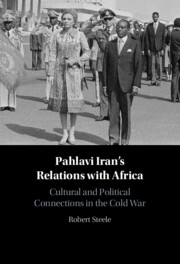Book contents
- Pahlavi Iran’s Relations with Africa
- Pahlavi Iran’s Relations with Africa
- Copyright page
- Contents
- Figures
- Acknowledgements
- Note on Transliteration
- Introduction
- Part I Establishing Relations (c. 1957–1970)
- Part II Forming an Africa Policy (1971–1975)
- 5 North Africa, Islam and the Great Civilisation
- 6 Trouble in the Horn and Soviet Encroachment
- 7 Iran and West Africa
- 8 Distributing the Oil Wealth
- Part III Africa and Pahlavi Iran’s Grand Strategy (1976–1979)
- Conclusion
- References
- Index
5 - North Africa, Islam and the Great Civilisation
from Part II - Forming an Africa Policy (1971–1975)
Published online by Cambridge University Press: aN Invalid Date NaN
- Pahlavi Iran’s Relations with Africa
- Pahlavi Iran’s Relations with Africa
- Copyright page
- Contents
- Figures
- Acknowledgements
- Note on Transliteration
- Introduction
- Part I Establishing Relations (c. 1957–1970)
- Part II Forming an Africa Policy (1971–1975)
- 5 North Africa, Islam and the Great Civilisation
- 6 Trouble in the Horn and Soviet Encroachment
- 7 Iran and West Africa
- 8 Distributing the Oil Wealth
- Part III Africa and Pahlavi Iran’s Grand Strategy (1976–1979)
- Conclusion
- References
- Index
Summary
During the 1970s, Iran’s relationships across Africa developed, both in terms of the number of ambassadors accredited to African countries, and in terms of the volume of trade and extent of political dialogue. At the beginning of the decade, Iran had diplomatic relations with just five countries in the whole of Africa – Algeria, Ethiopia, Libya, Morocco and Tunisia – but by the middle of the 1970s it had established formal ties with over thirty-five nations. This chapter investigates the nature of Iran’s diplomacy in Africa and why it was so successful during the 1970s. It questions why the shah was appealing to the independent states of Africa, and what strategies the regime employed to project an image of the shah as the leader of a country that had historically been an important global power and a civilising force in the world, and which aspired to continue to influence world affairs in a positive way. At the same time, after the British withdrawal from the Persian Gulf in 1971, the shah sought to expand Iran’s sphere of influence beyond its immediate neighbourhood towards the Indian Ocean.
- Type
- Chapter
- Information
- Pahlavi Iran's Relations with AfricaCultural and Political Connections in the Cold War, pp. 119 - 149Publisher: Cambridge University PressPrint publication year: 2024



